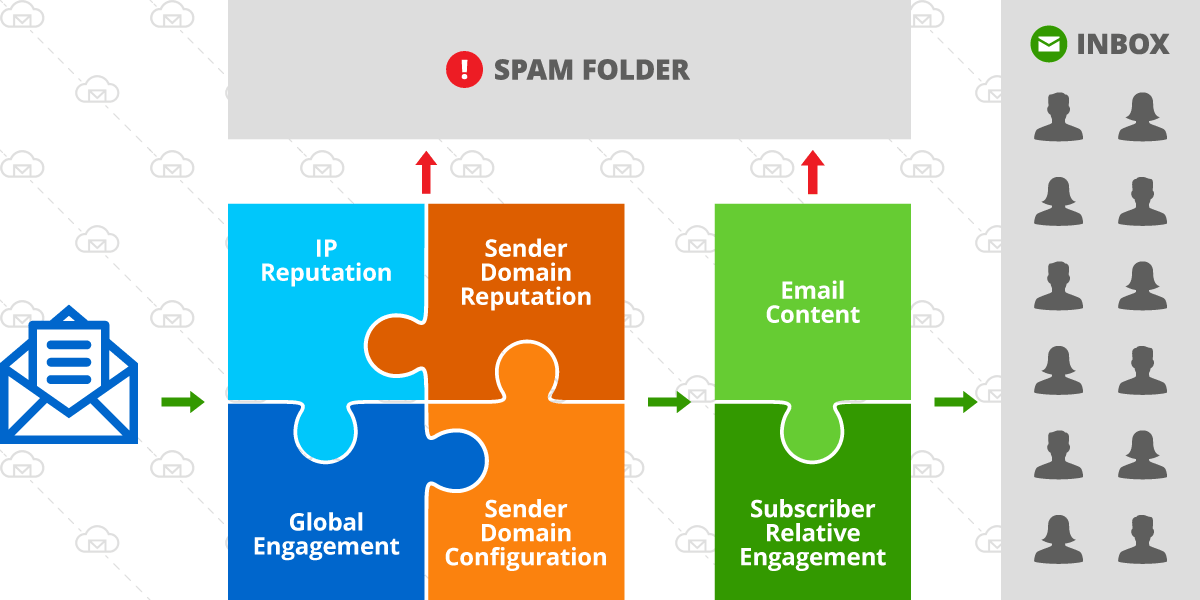If you work with email marketing campaigns you no doubt heard about dedicated IP (internet protocol) addresses. Perhaps you have been wondering about who uses them and if you should use one yourself. In this article, we explain what they are for and who should use them.
What is an IP?
IP (internet protocol) address is a unique address that identifies a device (computer or server) on the Internet or a local network. When you start using a hosted transactional or bulk email marketing service, by default, your emails are being sent from a group of servers with different IP addresses, and that group of servers is shared by multiple senders like you. So your emails go out from a “shared IP pool” and the reputation of those shared IP addresses is shared as well. The IP reputation is one of the factors that influences email deliverability and inbox placement.
IP Reputation as an Email Deliverability Factor
Lets make one thing clear – deliverability is not the same thing as inbox placement – an email in Spam folder is considered to be delivered. A lot of ESPs (email service providers) claim to have high deliverability, but that just means they can avoid delivery blocking by ISPs based on volume of emails sent from a single server/IP. High delivery rate is nice, but you still need to place into subscriber’s inbox, which is much harder than getting your email delivered.
Most ESPs are responsible for managing (and protecting) the reputation of the IP addresses used by their platform. For that reason, many ESPs turn away customers if/when they determine that their use of the platform may negatively affect other customers. Some platforms (like Mailchimp) scan the email lists customers upload to automatically determine its quality and can suspend account or campaigns based on that data. Many providers have a manual account or campaign review step for all new customers, so it’s not even possible to send a bulk campaign as soon as you sign up. This type of customer filtering and platform protection by market leaders results in 2 things:
- Desired customer pool with high quality senders and good email sending practices
- Higher prices for the service, in return for better IP reputation
So when you use a market leader like MailChimp or CampaignMonitor, that cost up to x10 more than some of the lower cost providers, you pay for “good company” in addition to extra features (e.g. multivariate testing, email template variety, direct integrations).
Does it mean that low cost email providers have lower quality IP pools than market leaders? No, if they are large enough they have many IP pools and likely sender quality tiers. Will your emails go to Spam folder if you use a cheap provider? It’s more likely, but not if all other email deliverability factors signal quality and you are placed into an IP pool with other good senders. ESPs have a way of ranking senders and grouping similar senders into appropriate IP pools. It’s a typical practice they don’t typically disclose to their customers, or everyone would ask to be on a better IP pool.
Email Deliverability Factors
Lets review the factors that affect deliverability, they are:
- IP reputation
- Sender reputation (e.g. sender being your domain or exact email address the emails are sent from)
- Server and domain configuration (DKIM, SPF, tracking links, etc)
- Global engagement
- Content and format of the email (spam words in subject or message body, format – use of images, etc)
- Relative engagement for you (sender) versus other senders in the recipients inbox

Email deliverability factors
On the diagram above, the green box represents factors that vary and change more with each campaign sent and the square on the left with 4 factors are not subject to dramatic changes on a per campaign basis. So with IP address reputation being only 1 of several factors, it can be a deciding factor in inbox placement but it depends on the quality score of the other factors as well.
Who Benefits from a Dedicated IP?
If you are a sender with established good reputation and high engagement history, and especially if you are sending low volumes of emails (less than 10,000 per day), you have a low risk of being affected by a switch of an ESP from a market leader to a lower cost provider. However, getting a dedicated IP address can help ensure your ongoing high deliverability in the future, as your list grows and mailbox providers adjust their inbox placement algorithms.
If you are a high volume sender (send more than 50,000 emails per day) and perhaps have been experiencing deliverability issues with your current provider, switching ESP might not give you an instant improvement unless you change some of the factors as well – improve list quality by removing invalid or inactive addresses, properly configure your domain for sending emails (have DKIM in place), invest in testing your email content and optimal send times.
You can benefit from a dedicated IP address IF:
- You are looking for a fresh start and looking to invest in building a strong email sender reputation with full control.
- You have a small list now, but plan to grow it fast and monetize it
- You have built up a sizable list (over 50,000 subscribers) and willing to invest in best practices and control your IP quality.
- You are an agency offering email marketing services to your clients.
Unfortunately, low volume senders are limited in their options because most ESPs don’t offer an option to get a dedicated IP address on lower pricing tiers. And if you use an ESP that does offer access to a dedicated IP, it may come with a hefty price tag. If you use an ESP that runs on Amazon SES, like BigMailer, you can request a dedicated IP(s) from Amazon anytime, at a cost of $25 per IP per month. Check out our comparison of bulk email marketing services to see how different providers accommodate use of dedicated IP addresses.
How Many IPs Do You Need?
The need for IPs is determined by your list size and your practices. Most providers recommend 1 dedicated IP for every 50,000 (Amazon) to 100,000 emails you plan to send to at the same time (in a single campaign).
Examples:
- If your list size is 50,000 and you send newsletters to entire list you need 1-2 IP addresses
- If your list size is 1,000,000 but you typically send to a segment of about 200,000 you need 2-4 IPs
- If you are an agency with clients sending at different times, your IP needs need to cover the largest campaign you send at any given time. So you may have a dozen or more customers with millions of subscribers in total, but only need 2-3 IPs for all your clients.
Warmup Process – IPs and Senders
The warmup process applies to both new IPs and new sender domains. Most ESPs have automatic IP warming in place, and not something you need to worry about, but you should confirm this before a switch. During an automatic IP warmup your dedicated IP would be sending small number of emails with the rest of the volume being sent from a shared pool. It can take anywhere from 1 month to 6 months to warmup your IP address(es) to send 100% of your emails, depending on sending frequency.
When starting to use a new sender domain you need to warm it up by sending smaller volumes at the start and gradually increasing it. Typically, you would start sending to your most active or recently signed up subscribers to ensure good engagement and to help establish your sender domain reputation.
Example warmup schedule:
- Day 1 – 500 emails
- Day 2 – 800 emails
- Day 3 – 1100 emails
- Day 4 – 1500 emails
If your email list is very diverse and your list is large, because you are trying to move your existing activity to a new sender domain, you can start with 2000-3000 emails per day and add about 25-40% per campaign (smaller increments for daily campaigns and larger increments for x2/week or weekly campaigns. Typically, it’s better to send more frequently with smaller volume increments, but it requires a bit more effort from the sender.
There are many providers that can help you warmup your new sender domain, like WarmupInbox that is meant for warming up new sender domains, or InboxAlly that can also help improve your engagement and deliverability. What those providers do is give you a seed list (or just send on your behalf) of email addresses they control to interact with your emails, to help establish your sender reputation.
Final Thoughts
Have you recently switched ESP and experienced a big change in inbox placement? Share your experience with us via live chat. If you are a BigMailer customer we would love to use your story for a case study.
Happy email marketing!
